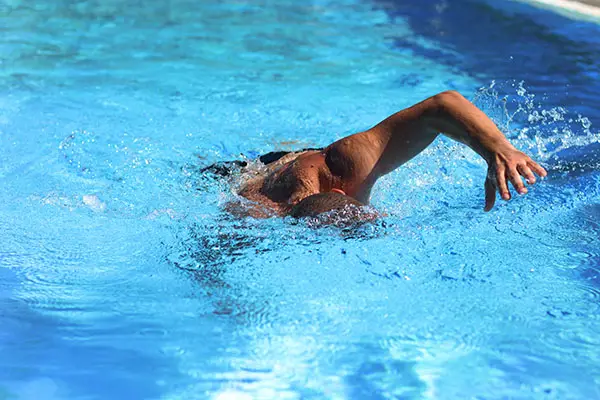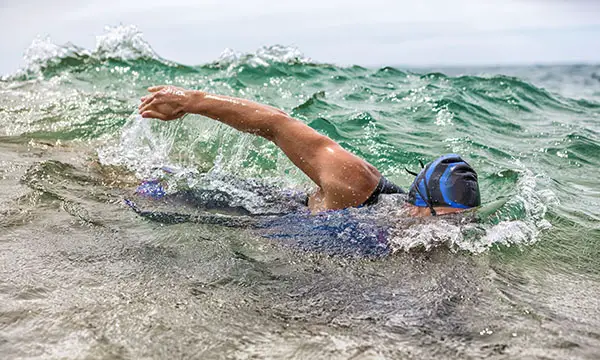Contents
How Long Does It Take To Swim A Mile?
The average swimmer can swim a mile in a pool in around 25-27 minutes.
Typically, we think of a mile in terms of running. Running a mile can take around 10 minutes, and you’re done!
Well, swimming is different.
The record for the fastest 1500 meter swim was actually set in February 2020 by Bobby Finke from the University of Florida. He swam the mile in 14:12.08.
The fastest female to swim a mile was Katie Ledecky, who swam the 1500 in just 15:20.48.
But, chances are, you are not a professional swimmer who is going for the world record. That means it is highly unlikely that you can swim a mile as fast as some people run one.
There are actually a lot of different factors that can affect your time.
Your swimming location, the quality of your form, athletic ability, fitness and water temperature are just a few to consider.
So, before we dive into more specifics, let’s look at the overall averages of how long it takes to swim a mile.
Average Time to Swim a Mile in a Pool
Believe it or not, it is easier for most people to swim a mile in a pool.
You don’t have to worry about any alternate factors that may get in your way that come with swimming in open water. Plus, it’s easier to keep track.
You can focus on your goal and accomplish it.

While there can be some variation depending on the size of the pool, most competitive swimmers clock their mile in around the 20 minute mark while the average swimmer can swim a mile in around 25-27 minutes.
Now, if you are very new to the exercise, you need to know that it might take upwards of 40-50 minutes to start in an indoor lap pool.
This will improve with your technique and as you build endurance.
Just know that if you’re just starting out, a mile can feel pretty daunting at first, and that is okay!
Average Time to Swim a Mile in Open Water
Swimming in open water (ocean, river, or lake) is definitely trickier than swimming in a lap pool.
This means that your average time to swim a mile is going to be slower.
On average, most people can swim a mile in open waters in about 30-35 minutes.
So, if you are new to swimming, you may even need to count on it taking around an hour.

But why does it take so much longer to swim a mile in open water?
Well, there will be all kinds of difficulties and challenges that you could face to affect your time, and here are just a few…
1. Temperature
Depending on the season, time of year, and location of your open water swimming session, extreme temperatures can slow you down.
Foremost, swimming in colder water can affect your breathing, which will exhaust your energy more quickly.
On top of this, if you are swimming in really cold waters, you’ll need a wetsuit.
Wetsuits can cause chaffing and sometimes claustrophobia, which will also affect your ability to swim at your fastest speed.
So, for an ideal swim time, if you are choosing to swim in open waters, swim in a warmer season or climate.
2. Visibility
In a pool, you can throw on your goggles and get to it!
But when you’re swimming in open water, visibility can cause quite the struggle.
Instead of just focusing on staying in your lane, you’re going to have to take more breaks, sighting where you are heading and keeping up with where you’ve been.
Sighting not only will slow you down from having to look up, but it will also use more energy.
More often than not, lakes and even ocean waters are a lot murkier than a pool, but if you want to swim in open waters, try picking a location where the water is more clear.
3. Calculated Distance
If temperature and visibility wasn’t enough, another challenge that many face when swimming in open water is that it is more challenging to get an accurate gauge on how far you have gone.
There are devices and watches that can calculate the distance in which you are going, but with lap pools, you have other reference points, such as laps, to keep you on track.
You may lose time by checking your distance frequently when swimming in open waters.
Now, as you become accustomed to swimming a mile, your body will become familiar with the time and effort it will take.
So, as you improve, you may not need to rely so heavily on your watch or device as often.
Average Time To Swim A Mile
How Many Swimming Laps is a Mile?
If you want to get your mile in more quickly without having to worry about the above mentioned challenges, then you’ll want to swim it in an indoor pool.
To swim a mile in an indoor pool, you’re going to need to know how many swimming laps are in a mile before you dive in and go for it.
Most pools in facilities such as universities or gyms are 25 yards or 50 meters in length.
For a 25 yard pool, with a lap being down a length and back, you would need to complete 33 laps to swim a mile.
With a 50 meter pool, however, you would only need to complete 15 laps!
If you are looking to swim a mile in a pool at your home or would like to know more about the history of swimming a mile, be sure to check out our article, How Many Swimming Laps is a Mile.
There are definitely pros and cons to swimming a mile in longer vs a shorter pool.
If you only have to complete 16 laps, you might find your stride and complete it more quickly.
It wouldn’t require as many stops and turns if you are not as skilled in flip turning, which could help you finish your mile more quickly.
However, if your endurance isn’t where you’d like it to be, the longer laps may require you to need longer breaks in between, affecting your time.
It all depends on the pool you have available to you and what pool will best serve you in completing your mile in a timely manner.
How to Swim a Mile Faster
How long does it take to swim a mile? Well, that greatly depends on you!
No matter where you are at in your fitness journey, there are always ways and things that you can do to improve.
So, if you’re not happy with your original time for swimming a mile or you simply want a new goal to beat your previous record, here are some things that you can do to swim a mile faster…
1. Build Endurance
Do you know what builds endurance? Cardio!
Is the pool and swimming a great form of cardio? Absolutely!
But it shouldn’t be your only form of cardio!
Cross training by doing cardio outside of the pool like running, hiking, biking, and more can really build up your endurance and help you improve your mile time.

Albert Einstein states, “The definition of insanity is doing the same thing over and over and expecting different results.”
Now, am I calling you insane for working hard and training? Not at all!
But I think you get my point!
If you want to swim a faster mile, you’re going to need to change things up, do different cardio exercises to build up your lungs and endurance, and you will start to see results!
2. Strengthen Muscles
Another way that you can increase your speed is by increasing the strength of the muscle groups that you will use while swimming.
If your muscles are stronger, they will work harder and for longer without needing as many breaks.

Dryland training, specifically focusing on your core, arms, and legs, will help you increase your swimming speed.
From incorporating different types of crunches each morning or doing a 7-day squat challenge, there are lots of fun and easy ways to add in some strength work to your everyday life!
3. Increase Swimming Distance Weekly
While cross-training a healthy amount, you could also look into increasing the total distance that you swim each week.
For example, if you go to the pool twice a week, and each time that you are there, you swim 8 laps in a 50 meter pool (about half a mile), then you are swimming about a mile each week.
From there, you could look to add another lap, then another 2, and continue to build your distance.
But, when you are increasing your swimming distance, be sure to do so at a sustainable rate.
If you are swimming a mile a week, we do not advise that you jump to 2 miles per week right away.
If you were to do this, there is a high probability that you could either over exhaust yourself or feel burnt out!
Neither of which will cause your swimming speed to improve!
4. Improve your Form
Maybe you are giving it your all, and you are doing all the things listed above, and you just feel like you’ve hit a wall with your timed mile.
Well, if this is the case, think about improving your freestyle form.
There are so many tweaks and slight changes that would shock you at how much of a difference they can make!
From your head or elbow positioning to the timing of your breathing, these subtle changes can really add up and make a huge impact on your overall mile time.
5. Work on Breathing
Breathing is one of the most difficult things to get the hang of when swimming longer distances.
Getting out of breath running can slow you down, but getting out of breath while trying to swim can bring your workout to a screeching halt!
There are all kinds of breathing drills available online that can help you improve your breathing and your breathing technique while swimming freestyle.
Once you’ve got your endurance where you’d like it, your swimming form solid, and your breathing technique squared away, you will be absolutely astonished at how long it will take you to swim a mile.
Conclusion
Swimming a mile is quite an achievement. Whether it is easy or a challenge, it’s good to be able to answer the question—how long does it take to swim a mile?
Our answer is it depends—as there are several factors to consider.
Are you swimming in a pool? If so, your times will be quicker than if you were swimming in the ocean.
Are you a beginner or an advanced swimmer? Beginner swimmers will take longer than advanced swimmers who are conditioned to swimming a mile.
If you are swimming in open water (ocean or lake), you will have other factors to contend with that may affect your time. Some of these factors are temperature, visibility, waves and wind.
To swim a mile faster, there are things you can focus on that will help to decrease your time.
Doing cross training on days you are not swimming, strength work to strengthen your core, arms and legs will help.
Slowly increasing your weekly swimming distance, improving your freestyle technique and working on breathing drills will help you to swim your mile faster.
So, when someone asks you, “How long does it take to swim a mile?” You can share your journey from a 50 minute mile to a 25 minute mile with a little dedication and some hard work.

